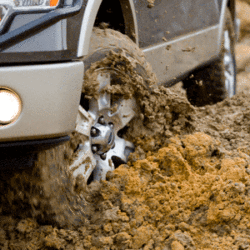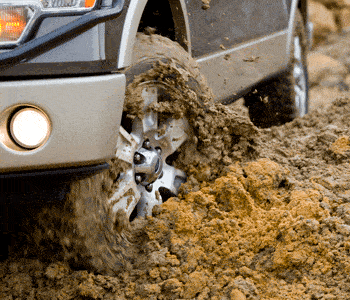Everything You Need To Know About Mud Tires


Types
Basic mud tires are designed for trucks that are typically driven on roads with occasional use in mud. Their tread patterns generally resemble those of standard tires although the treads may be up to one inch deep. These tires provide a comfortable ride on hard surfaces, while still being able to dig into mud.
The characteristics of a medium mud tire lie between a basic and extreme mud tire. The most popular type of mud tire and are primarily designed for drivers who spend most of their time in mud. The tread depth on these tires is typically between one and 1.5 inches, allowing them to quickly sling mud out of the tread. They also provide good traction in other soft terrain such as sand and snow.
Extreme mud tires are designed exclusively for driving in mud, commonly known as mud bogging. They have very large, treads with a minimum depth of 1.5 inches, allowing the tires to push a vehicle through deep mud. Extreme mud tires are typically used on large-bore ATVs that often must be modified to accommodate these large tires.
Tire Width
The ideal width of a mud tire primarily depends on the specific type of mud you’ll be driving through. For example, narrow tires are best for a soft layer of mud on top of a hard bottom layer. These tires can cut through the top layer to gain traction in the hard layer below. In comparison, a wide tire will have a tendency to float on the top layer without ever reaching hard mud, a phenomenon commonly known as hydroplaning.
A wide mud tire is best for mud with a thick cement-like consistency, especially when the terrain below is variable. This tire’s tendency to hydroplane is also useful for driving on sand. Wide tires are also better suited to under inflation, commonly known as “airing down.” This technique increases the contact area between the tire and the terrain, thus improving traction. Mud boggers with wide tires often air down by 15 to 20 pounds per square inch (psi), although the exact amount depends
on factors such as the tire’s size and stiffness.
Tread Pattern
A tire’s tread pattern is generally composed of lugs and voids. Lugs are the portion of the tread that protrude above the tire’s surface, while the voids are the grooves in the tire that separate the lugs. Mud tires generally have larger lugs and wider, deeper voids than standard tires. This design causes mud to be channeled out of the tread when the tires spin through mud, effectively self-cleaning the tire.
The manufacturer’s tread pattern typically determines a mud tire’s success, which vary greatly between manufacturers. The lugs on a mud tire can be highly effective at hooking themselves around solid terrain under the right conditions. This benefit generally requires the tires to be properly aired down so the voids can effectively channel mud away from the center of the tire. Otherwise, the voids can become tightly packed with mud, giving the tire a completely smooth surface. Once this happens, the voids often must be cleared manually before the tire can obtain any significant traction.
Narrow voids are more useful for dry, soft surfaces, especially with wide tires. This type of tire is especially useful for sand dunes, which effectively have no bottom. Tires with narrow voids tend to stay on top of the surface instead of digging down, as is the case with wider voids.
http://www.pureoffroad.com/mud_atv_tires.htm
http://www.offroaders.com/info/tech-corner/reading/mud.htm